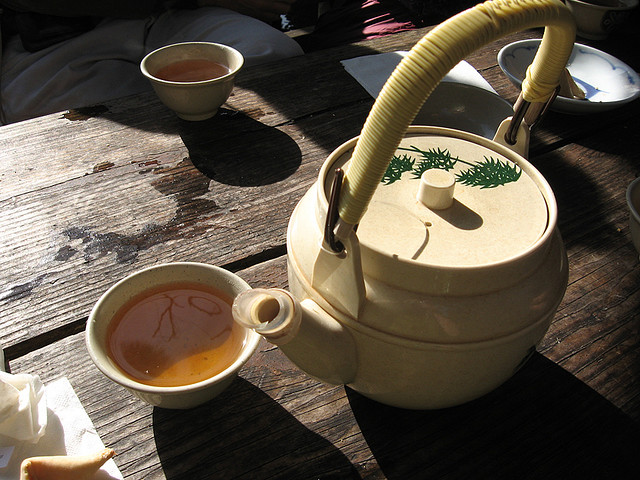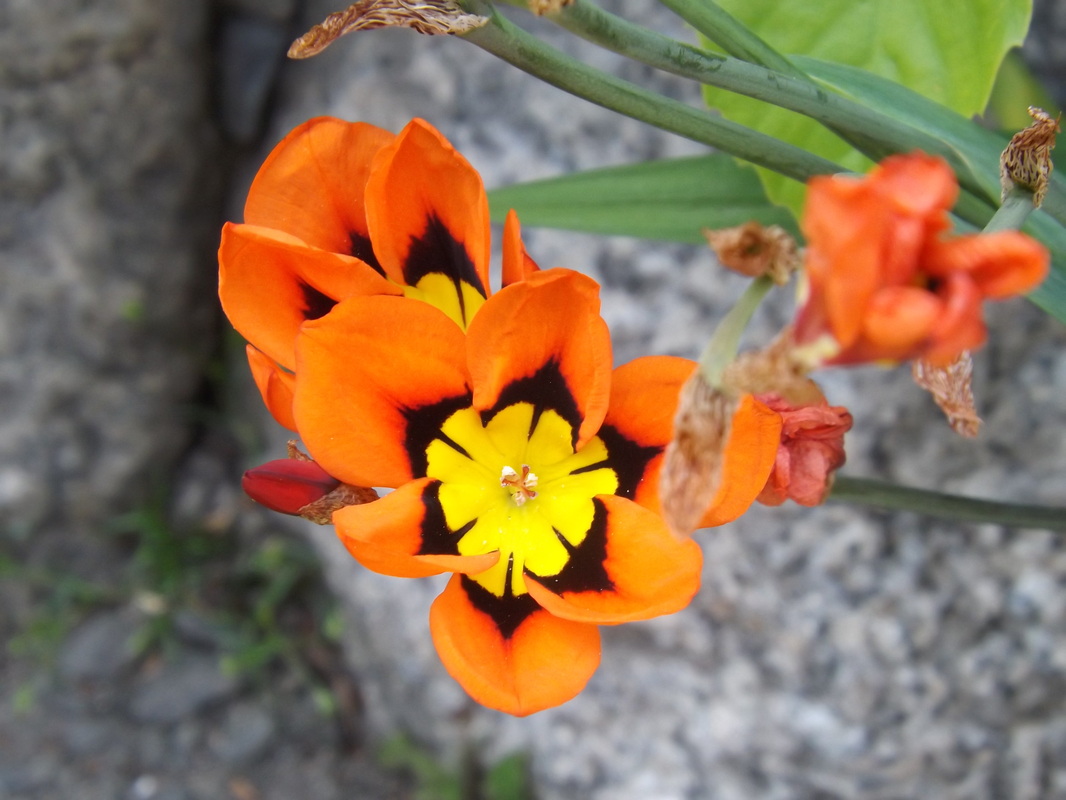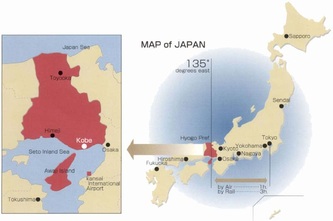As I approach the end of my exchange trip and reminisce about all the adventures I had and things I saw, I wonder: what was with all the flowers?
Just a few of the many flowers you're likely to see here. | | No matter the location or season here in Japan, you can bet you will always see flowers. During my stay, I've seen them everywhere from gardens, parks and temples, to clothes, artwork and advertising. They're even common decoration on food! So it pretty much goes without saying that flowers are very loved here in Japan. But why exactly is that? Well if I had to guess, I would say it's because of Japan's unique appreciation of nature. As I mentioned in my earlier post on Japanese conservation, people in Japan appreciate nature for mostly aesthetic reasons. If we were to compile a list of things in nature Japan loves, flowers would be somewhere at the top of that list. This is because flowers are not only beautiful to the country, but highly symbolic. They not only represent beauty, but impermanence. Happiness and sadness. Life and death. When flowers bloom, it is intense beauty,but this vibrance is short lived. Since the Heian period (794-1185) this has been observed through flower viewing (花見/hanami) and reflected on in poetry and artwork. People started to take this symbolism to heart and some-like the samurai- sought to live their lives in the same manner as a flower; short, but beautiful and intense. It may be because of this that Japan has grown so fond of flowering plants. A Floral Calendar  Apart from the aesthetic and philosophical appeal of flowers, they're also a great way to get a sense of seasonal changes in Japan. I've been told there's a flower to represent each month here. The only time the focus shifts away from flowers is during fall (particularly October and November) when the public marvels at the crimson display of maple leaves (better known as 紅葉/momiji here).
Japan guide has a good visual guide to the general blooming periods of Japan's most loved flowers here. If you'd like to see this floral calendar for yourself, there's no better way than to experience it yourself. Coming to understand Japan's love for flowers will not only help you better appreciate Japanese culture, but flowers as well. | Momiji; the honorary flower for the autumn months. |
 Pic Source: Flickr.com In my previous post on Japanese food ( Japanese food : The Link to culture), I mentioned how the food here says a lot about the culture. There are many foods that one may associate with Japan. But of all these dishes and drinks, none seem as integral to Japanese culture as tea.
There seems to be this big hype about tea these days. It is in fact currently the most commonly consumed beverage in the world. But Japan was into the stuff way before it was cool. This brilliant drink was introduced to the country centuries ago during the Nara period (710-794), around the same time Buddhism was sweeping the nation. Practicing monks drank tea as an alternative to alcohol, and would bring it with them during their travels. By the Edo period (1603-1867) tea was a common drink in every household of Japan. Now while Japan isn't the only country to fall in love with tea, they're probably one of the only ones to harbor an intense tea culture. Japan has practically perfected making tea here and even has a full blown ceremony for it (if you wanna know more about Japan's tea ceremony, I'd recommend checking out japanese-tea-ceremony.net). The high value placed on tea may have something to do with its deep ties to Zen Buddhist principles (simplicity, harmony etc.) but we'll never really know that for sure. What we do know is that tea is insanely popular here in Japan. It can be found almost anywhere, in many types, strengths and flavors, but the standard tea here is green tea. If someone in Japan offers you お茶 (ocha) without specifying the type, you can bet they're referring to green tea. If you're unsure of what tea to drink in Japan, tofugu has a fun post on it here. Tea gets a lot of praise or being a healthy alternative drink, but keep in mind this isn't the only reason people drink it. Japanese people seem to drink it for the taste. I say this because virtually everything has a 抹茶(maccha- powdered green tea) or お茶 (ocha-green tea) flavor option. Kit Kats, ice cream, gum, cookies, and even tic tacs have this option. Think of it like Japan's vanilla. When you take into account traditional Japanese food, ocha fits nicely into the nation's palate. It has a clean defined flavor without being too overbearing. This makes it perfect to couple with traditional foods that often have unique and/ or subtle flavors that may be easily overpowered or diluted by other beverages (save for water). The health benefits are a definite plus though... And those are just a few of the many facts about tea in Japan. So if you ever stop by for a visit, take my advice and grab a cup o tea. It's an easy and tasty way to break into Japan's food culture.
| | A good way to learn about other cultures is by examining (and eating) the local diet. Coming to Japan with this in mind, i sought out Japanese food that hasn't really bled over into American co-cultures. But here's the rub: as much as we like to "Americanize" food, Japan too takes foreign food and makes it "Japanese". And since I live in the city that is the shore on which the waves of foreign influences relentlessly crash upon, I see a lot of this "Japanized" food.
This got me thinking: what foods here are purely Japanese??? |
While I may live in a modern city in Japan, I'm fortunate it also lies in the traditional center of Japan (see previous blog for more info.). As it turns out the area has a surplus of unique and delicious foods. The three main cities of kansai- Kyoto, Osaka and Kobe- each have distinct tastes and styles of cooking. Here are are few dishes of the Kansai area.
I wanted to do know more about the city I'm living in. So I did some digging and found some information on Kobe city and the Hyogo prefecture.
 Mascot of the Hyogo prefecture. Mascot of the Hyogo prefecture. The Hyogo prefecture is a major cultural hot spot of Japan. Located near the old capitol Kyoto, this prefecture is a part of an area known as the kansai region. For over a century this area was the center of Japan. This area is even thought to be the birthplace of the country in Japanese mythology. Ancient temples and feudal castles like Himeji serve as evidence of the prefecture's traditional past.
Before the Meiji restoration (around 1867 or so), the area known today as Hyogo was constantly being divided up into regions and territories. This was due to battles and wars of various clans throughout Japan's history. As a result, cities are more focused on in the history books when referring to the location of events. It then goes without saying that these cities have more color in their history. Kobe (the city I currently reside in) is a great example of this.
Kobe has been a major city and trading port of Japan since the eighth century (WOW). Initially being a major spot for trade with China and later western countries after Japan opened its borders in 1868, there is a high level of international influence that can still be seen today. Since Kobe was one of the first cities to open its borders for trade, the city developed a settlement to conduct business with foreigners (cleverly named the "foreign settlement"). This is currently a popular tourist spot and many western style buildings and establishments can still be found today. This exposure and influence of foreign culture thus makes Kobe a sort of gateway to the global community; as tastes and trends of other countries often start in Kobe and spread to the rest of Japan.
If you want more information on the interesting and awesome things in Hyogo, you should check out their tourism website.
 Hey guys. So my first cultral blog about Japan is on (you guessed it) cherry blossoms. I arrived just as the cherry trees were reaching full bloom. I greatly enjoyed walking around and viewing these beautiful flowers and even took some great pictures (^o^). I talk a bit about this but I mainly wanted to share what I learned about cherry blossoms in Japanese culture, so here it goes:In Japan, springtime is the time for new beginnings. It marks the start of the new school year as well as the fiscal year. Many also begin new jobs at this time. Spring is also the time of cherry blossoms (aka sakura「桜」). These flowers are the symbol change and new beginnings in the country, and are a major part of Japanese culture. For centuries, Japanese people have enjoyed viewing cherry blossoms. This custom is called Hanami (花見), and originated during the Nara period (710-784 A.D). It was initially enjoyed by the imperial court and people of very high social status.However, this tradition eventually shifted to a custom enjoyed by everyone during the Edo period (1603-1868), and is a major part of the culture today. This custom is so valued, special news reports regarding the "cherry blossom forecast" are watched closely by everyone to determine the best time to hanami. People usually celebrate this season by having a picnic with family and friends, but you can also just take a walk and admire the flowers as well. There are a few online guides on how to properly hanami. A nice one to look at is the step by step guide on japanican's website.
|











 RSS Feed
RSS Feed